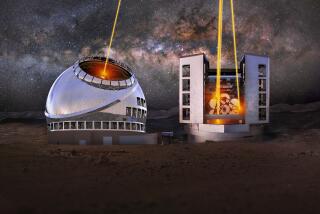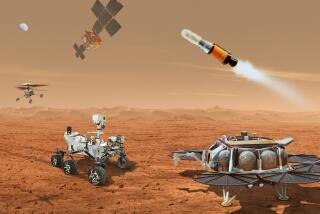This telescope could help us explore the heavens, but it’s stuck in coronavirus limbo
- Share via
Inside a nondescript gray steel industrial facility in Redondo Beach, the nation’s largest scientific effort is trying to overcome a virus so tiny that only electron microscopes can see it.
The M8 High Bay at Northrop Grumman’s Space Park is where scientists are conducting final testing of the massive Webb Space Telescope before its scheduled launch in one year.
But because of the coronavirus pandemic, NASA has clamped down on its space work, California has ordered a suspension of all nonessential human activity and the project’s operations have slowed to a crawl.
No longer are engineers, scientists and aerospace technicians streaming into the plant at 5:30 a.m., six days a week, working until 11:30 p.m. to meet an ambitious March 2021 launch target.
While questions abound about a project aimed at observing the first starlight in the universe, billions of years ago, the Webb team so far is holding the line on meeting that deadline.
“We have been delayed a number of times before,” said William Ochs, the NASA project director overseeing its construction. “The science community is anxious for the Webb telescope to get up there and start making those wonderful observations and wild discoveries it will make.”
The Webb is designed to look for the first light to streak across the dark universe more than 13 billion years ago, which is now just a faint infrared signal that has never been observed. It is thought to hold secrets about the very creation of the heavens.
The Webb would capture that light on a massive 6.5-meter (21.3 feet) diameter mirror, the largest of any space telescope, parked a million miles from Earth in cold space. At $8.8 billion, it is almost certainly the most costly machine ever built, nearly twice the price of the Large Hadron Collider in Switzerland.
It has been repeatedly delayed by technical challenges. Now that most of those multiple system problems have been resolved, NASA and its partners at Northrop Grumman are facing the reality that this pandemic could force new setbacks.

Ochs said Tuesday that he couldn’t have predicted any of the obstacles that hit the project, but “the virus was pretty far out there.”
Now, the March 21 launch date faces an extraneous challenge, he acknowledges. The schedule has 52 days of “reserve” time for unexpected problems, so the project could conceivably overcome a short delay caused by the virus.
But realistically, he said, it is not possible to just turn off and turn on the current status of the project, in which the assembled machine is tested as a whole.
The program has about 900 tasks to complete before the telescope is loaded on an unmarked truck and driven in the middle of the night to a secret berth in Los Angeles harbor, where it will be shipped under military escort to the Ariane rocket launch pad in French Guiana.
Ochs, a veteran NASA engineer who likes golf and woodworking, has cut weekend work to allow his employees to spend more time with their families.
The 45 engineers and scientists from the East Coast who normally work side by side with the Northrop Grumman team at the Redondo Beach plant are down to 15. And normal routines are taking longer, such as more time to don clean room garb that protects the telescope from contaminants.
Ochs vows that work force safety is his highest priority, and said he gives every employee the right to decline work. So far, nobody on the team is known to be infected, he said.
“We are still working,” Ochs said. But at some point in April when it comes time to test the satellite’s sunshield towers, the work may have to be suspended entirely. Without a resumption in a month or two the schedule will be blown up.
Cristina T. Chaplain, who oversees space program reviews at the Government Accountability Office, an arm of Congress, said a lot of scientific missions have been waiting for Webb to launch so they can move forward.
NASA could be working out of “a desire not to blow another deadline,” she said. A report she issued in January before the widespread U.S. virus outbreak gave the project a low probability of meeting its launch date.
“There is definitely a lot of political pressure on the program,” she said.
The latest maps and charts on the spread of COVID-19 in California.
The Webb soared in cost from an initial industry estimate of $2 billion to the current $8.8 billion and the operational date has slipped by years. The Hubble also experienced cost growth, but the public decided it was worth the money when it saw the photographs, said Marco Caceres, senior space analyst at market research firm Teal Group.
“Things like this are at the core of NASA’s mission,” he said. Another delay should be expected, he said, adding, “I wouldn’t count on launching this spacecraft until the summer of next year, at the earliest.”
The delays and cost increases are one measure of the telescope’s complexity. Almost every assembly step is carefully rehearsed, sometimes repeatedly, before the telescope is touched, said Scott Willoughby, Northrop Grumman’s program manager.
“We don’t want to break anything,” he said.
Just several months ago, two key systems, a transmitter tube and a telemetry processor, were judged unreliable and had to be delicately extracted from the telescope and replaced, a hands-on job performed by a beefy technician who lifts weights.
If the light that Webb will see is 13 billion years old, why should another few months matter? Though Ochs’ top priority is the safety of his people, he also is driven by the prospect this project could be a celestial game changer.
The program has tantalized astronomers and cosmologists for a quarter century. The starting point of Webb was the mid-1990s, when a group of cosmologists gathered in the office of then NASA Administrator Dan Goldin.
“They said they needed a replacement for the Hubble space telescope and wanted one with a 4-meter mirror,” Goldin recalled. “I told them that was the dumbest thing I could think of. I threw them out of my office.”
About the same time, Goldin asked California astronomer Alan Dressler what he would need to work on the most important scientific questions, and Dressler told him a 6-meter or 7-meter mirror that could operate just above a temperature of absolute zero.
The mirror would have a surface seven times larger than Hubble, which would be too big to fit in any rocket. Goldin wanted to make it unfold in space like rose pedals.
When astronomers and aerospace engineers told Goldin it couldn’t be done, he branded them as “Hubble Huggers,” people who only wanted to duplicate what had already been done. In a speech to the American Astronautical Society in 1995, Goldin asked them to take on the challenge.
“People were worried and excited at the same time,” Dressler said in an interview. “But that is how great things are done at the edge. I give him credit.”
Dressler called Webb “an unprecedentedly complex mission” that would attempt to collect just a few hundred photons of light, a few thousand with luck, from the first stars, hundreds of millions of years before even the first galaxies formed.
Although he is anxious for the discovery, he said the science community understands the risks posed by the virus. “Another six months wouldn’t have that much of an impact,” Dressler said.
More to Read
Sign up for Essential California
The most important California stories and recommendations in your inbox every morning.
You may occasionally receive promotional content from the Los Angeles Times.













